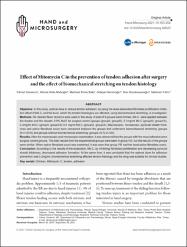Effect of Mitomycin C in the prevention of tendon adhesion after surgery and the effect of biomechanical stretching on tendon histology

View/
Access
info:eu-repo/semantics/openAccessDate
2021Author
Güvercin, YılmazAbdioğlu, Ahmet Atilla
Baki, Mehmet Emre
Kerimoğlu, Gökçen
Karahasanoğlu, İlker
Yıldız, Mehmet
Metadata
Show full item recordCitation
Güvercin, Y., Abdioğlu, A.A., Baki, M.E., Kerimoğlu, G., Karahasanoğlu, İ. & Yıldız, M. (2021). Effect of Mitomycin C in the prevention of tendon adhesion after surgery and the effect of biomechanical stretching on tendon histology. Hand and Microsurgery, 10(3), 193-202. http://doi.org/10.5455/handmicrosurg.69020Abstract
Objective: In this study, optimal dose to reduce tendon adhesion, by using the dose-dependent fibroblast proliferation inhibition effect of Mit-C, and the level, which the tendon histologies are affected, using biomechanical stretching, is investigated.
Methods: 56 chicken flexor tendons were used in this study. A total of 9 groups were formed. Mit-C were applied between
the tendon and the sheath; 0.9% NaCl for surgical control groups (groupII, groupIII), 0.1mg/ml Mit-C (groupIV, groupVII),
0.2mg/ml Mit-C (groupV, groupVIII) 0.5 mg/ml Mit-C (groupVI, groupIX). Macroscopic, microscopic, synovial sheath thickness and active fibroblast count were compared between the groups that underwent biomechanical stretching (groups
III,V,VII,IX) and groups without biomechanical stretching (groups I,II,IV,VI,VIII).
Results: After the macroscopic and microscopic examination, it was observed that the groups with the most adhesion were
surgical control groups. The best results from the experimental groups were seen in group VIII, but the results of the groups
were similar. When active fibroblast count was examined, it was seen that group VIII had the least active fibroblast count.
Conclusion: According to the results of the evaluation, Mit-C, by inhibiting fibroblast proliferation and decreasing synovial
sheath thickness, decreased adhesion formation. At the same time, it was concluded that the optimal dose for adhesion
prevention was 0.2mg/ml, biomechanical stretching affected tendon histology and the drug was suitable for clinical studies.

















